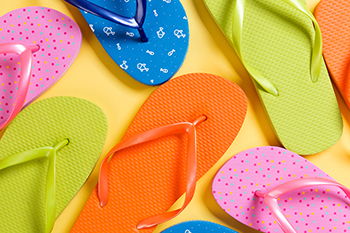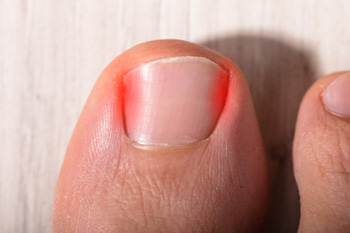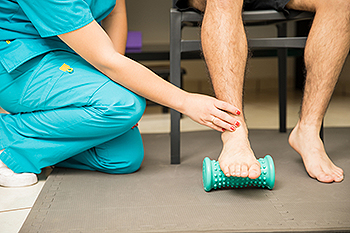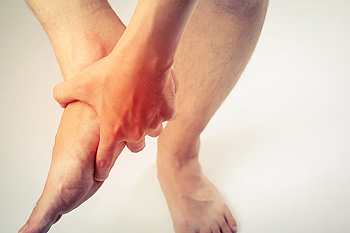June 2022
The Pros and Cons of Wearing Flip Flops

The simplicity of wearing flip flops during the summer months is appealing for many people. They are designed in different colors and styles, and have become a popular shoe. Despite their ease, they lack structural support, and this can affect the ankles, calves, heels, and feet. They are beneficial to wear in public areas where there are swimming pools and locker rooms. They are considered to be an appropriate shoe that may help to prevent athlete’s foot and toenail fungus while worn in these types of areas. Flip flops can be purchased with cushioned soles, and leather material. Additionally, it is beneficial to choose these types of shoes that have a strap in the back, which can be helpful in keeping the shoe on the foot. When the wrong type of flips flops are worn, the gait may gradually be affected, and pain may be felt in the feet. If you would like more information about the pros and cons of wearing flip flops, please schedule an appointment with a podiatrist.
Flip-flops can cause a lot of problems for your feet. If you have any concerns about your feet or ankles, contact Eveleigh Williams, DPM from Sole 2 Sole, PC. Our doctor will assist you with all of your foot and ankle needs.
Flip-Flops and Feet
Flip-flops have managed to become a summer essential for a lot of people. While the shoes may be stylish and easy to slip on and off, they can be dangerous to those who wear them too often. These shoes might protect you from fungal infections such as athlete’s foot, but they can also give you foot pain and sprained ankles if you trip while wearing them.
When Are They Okay to Wear?
Flip-flops should only be worn for very short periods of time. They can help protect your feet in places that are crawling with fungi, such as gym locker rooms. Athlete’s foot and plantar warts are two common fungi that flip-flops may help protect your feet against.
Why Are They Bad for My Feet?
These shoes do not offer any arch support, so they are not ideal for everyday use. They also do not provide shock absorption or heel cushioning which can be problematic for your feet. Additionally, you may suffer from glass cuts, puncture wounds, and stubbed toes since they offer little protection for your feet.
More Reasons Why They Are Bad for Your Feet
- They Slow You Down
- May Cause Blisters and Calluses
- Expose Your Feet to Bacteria
If you have any questions, please feel free to contact our office located in Olympia Fields, IL . We offer the newest diagnostic and treatment technologies for all your foot care needs.
Painful Ingrown Toenails

Ingrown toenails are often painful. They typically develop due to wearing shoes that do not fit correctly and this can force the nail to grow into the surrounding skin. Furthermore, they can occur by improperly trimming the toenails or result from a toe injury. In addition to pain, this condition can be accompanied by swelling, redness, and pus that may drain from the affected toe. Some patients can find mild relief by soaking the foot in warm water and using a piece of cotton to push the skin away from the nail. This is considered to be temporary, and will most likely need professional attention soon after. An ingrown toenail may be more common in adults than children as well as people who have curved or thick nails. If you have symptoms of this condition, it is strongly suggested that you consult with a podiatrist who can effectively treat this condition.
Ingrown toenails can become painful if they are not treated properly. For more information about ingrown toenails, contact Eveleigh Williams, DPM of Sole 2 Sole, PC. Our doctor can provide the care you need to keep you pain-free and on your feet.
Ingrown Toenails
Ingrown toenails occur when a toenail grows sideways into the bed of the nail, causing pain, swelling, and possibly infection.
Causes
- Bacterial infections
- Improper nail cutting such as cutting it too short or not straight across
- Trauma to the toe, such as stubbing, which causes the nail to grow back irregularly
- Ill-fitting shoes that bunch the toes too close together
- Genetic predisposition
Prevention
Because ingrown toenails are not something found outside of shoe-wearing cultures, going barefoot as often as possible will decrease the likeliness of developing ingrown toenails. Wearing proper fitting shoes and using proper cutting techniques will also help decrease your risk of developing ingrown toenails.
Treatment
Ingrown toenails are a very treatable foot condition. In minor cases, soaking the affected area in salt or antibacterial soaps will not only help with the ingrown nail itself, but also help prevent any infections from occurring. In more severe cases, surgery is an option. In either case, speaking to your podiatrist about this condition will help you get a better understanding of specific treatment options that are right for you.
If you have any questions please feel free to contact our office located in Olympia Fields, IL . We offer the newest diagnostic and treatment technologies for all your foot and ankle needs.
Can Stretching Help Plantar Fasciitis?

The foot condition that is known as plantar fasciitis affects the heel and the arch. It happens as a result of an inflamed plantar fascia, which is the band of tissue that is located on the sole of the foot. It connects the heel to the toe. This problem is often painful. This is a common foot condition among athletes or in people who stand for long periods of time throughout the day. Plantar fasciitis gradually develops, and can cause pain while walking upon arising in the morning. Additionally, it may occur from genetic factors, wearing shoes that do not fit correctly, or from running on uneven surfaces. Many patients are aware of stretches that can be practiced which may bring mild relief. These can include a heel drop which is done by standing on a step, and lowering the heels one at a time until a gentle stretch is felt. Range of motion exercises can be done that may help to generally increase the strength of the overall foot. If you are afflicted with plantar fasciitis, it is suggested that you confer with a podiatrist who can effectively diagnose and treat this condition.
Plantar fasciitis is a common foot condition that is often caused by a strain injury. If you are experiencing heel pain or symptoms of plantar fasciitis, contact Eveleigh Williams, DPM from Sole 2 Sole, PC. Our doctor can provide the care you need to keep you pain-free and on your feet.
What Is Plantar Fasciitis?
Plantar fasciitis is one of the most common causes of heel pain. The plantar fascia is a ligament that connects your heel to the front of your foot. When this ligament becomes inflamed, plantar fasciitis is the result. If you have plantar fasciitis you will have a stabbing pain that usually occurs with your first steps in the morning. As the day progresses and you walk around more, this pain will start to disappear, but it will return after long periods of standing or sitting.
What Causes Plantar Fasciitis?
- Excessive running
- Having high arches in your feet
- Other foot issues such as flat feet
- Pregnancy (due to the sudden weight gain)
- Being on your feet very often
There are some risk factors that may make you more likely to develop plantar fasciitis compared to others. The condition most commonly affects adults between the ages of 40 and 60. It also tends to affect people who are obese because the extra pounds result in extra stress being placed on the plantar fascia.
Prevention
- Take good care of your feet – Wear shoes that have good arch support and heel cushioning.
- Maintain a healthy weight
- If you are a runner, alternate running with other sports that won’t cause heel pain
There are a variety of treatment options available for plantar fasciitis along with the pain that accompanies it. Additionally, physical therapy is a very important component in the treatment process. It is important that you meet with your podiatrist to determine which treatment option is best for you.
If you have any questions, please feel free to contact our office located in Olympia Fields, IL . We offer the newest diagnostic and treatment technologies for all your foot care needs.
Wounds That Don't Heal Need to Be Checked
Bone Spurs

Bone spurs or osteophytes are smooth growths of bone that can develop throughout the body, over a long period of time. Common areas for such spurs to occur include heels, ankles, and big toes. They are a natural part of aging but also can be a progression of certain medical conditions, such as osteoarthritis. In fact, joint damage from osteoarthritis is the most frequent cause of bone spurs. Bone spurs are not painful in and of themselves but can become painful when they push into surrounding tissue and nerves. If there are no symptoms, bone spurs do not have to be treated, however, if they cause pain, treatment should be undertaken. Some common suggestions for alleviating the pain of foot bone spurs include maintaining a healthy body weight to take pressure off joints and doing exercises to stretch and strengthen muscles around joints, resting, and icing the affected area. Surgery may be needed to remove bone spurs if inflammation and pain become debilitating. If you have a troublesome bone spur on your foot, it is best to see a podiatrist to discuss the best treatment to alleviate your pain.
Foot Pain
Foot pain can be extremely painful and debilitating. If you have a foot pain, consult with Eveleigh Williams, DPM from Sole 2 Sole, PC. Our doctor will assess your condition and provide you with quality foot and ankle treatment.
Causes
Foot pain is a very broad condition that could be caused by one or more ailments. The most common include:
- Bunions
- Hammertoes
- Plantar Fasciitis
- Bone Spurs
- Corns
- Tarsal Tunnel Syndrome
- Ingrown Toenails
- Arthritis (such as Gout, Rheumatoid, and Osteoarthritis)
- Flat Feet
- Injury (from stress fractures, broken toe, foot, ankle, Achilles tendon ruptures, and sprains)
- And more
Diagnosis
To figure out the cause of foot pain, podiatrists utilize several different methods. This can range from simple visual inspections and sensation tests to X-rays and MRI scans. Prior medical history, family medical history, and any recent physical traumatic events will all be taken into consideration for a proper diagnosis.
Treatment
Treatment depends upon the cause of the foot pain. Whether it is resting, staying off the foot, or having surgery; podiatrists have a number of treatment options available for foot pain.
If you have any questions, please feel free to contact our office located in Olympia Fields, IL . We offer the newest diagnostic and treatment technologies for all your foot care needs.









